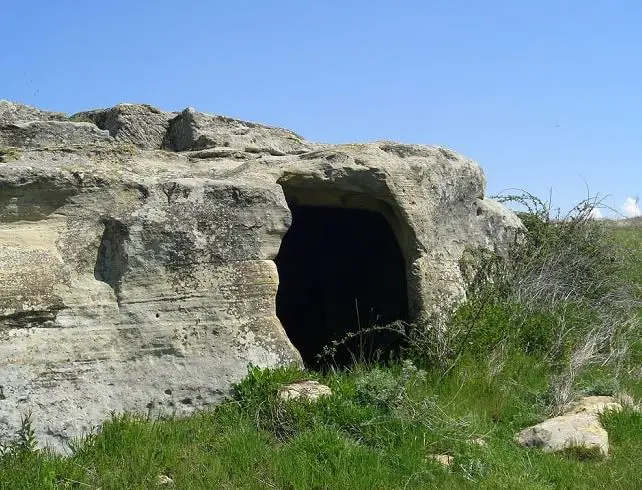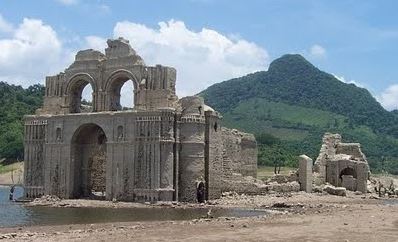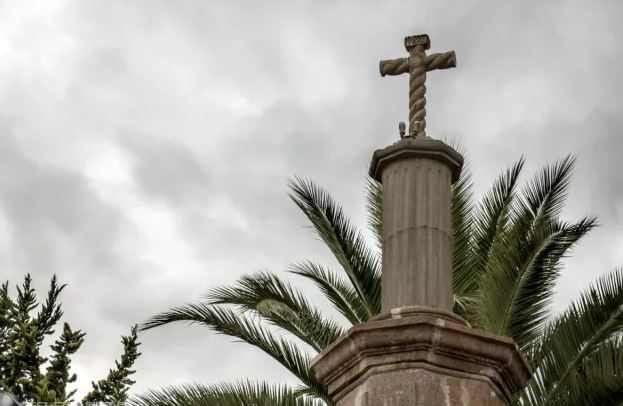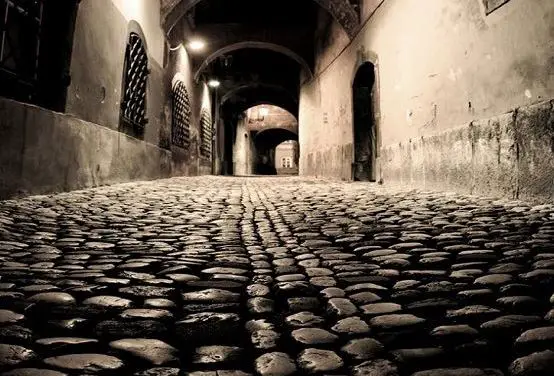Podcast: Play in new window | Download
Subscribe: Apple Podcasts | RSS
Not to be confused with the country of Mexico or the Valley of Mexico or even the capital of the country, Mexico City, the state in Mexico called México is located in the south-central part of the country. The State of México surrounds Mexico City on three sides and to the north it borders the states of Querétaro and Hidalgo. It also borders Morelos and Guerrero to the south, Tlaxcala and Puebla to the east and Michoacán to the west. It is the most populated and the most densely populated of all the states in Mexico. It is also home to many legends. Here are four.
- Juan Ruiz Meets the Devil
There is a rock on the road to Tlamacas where, according to this legend, the devil appears. It is said that a poor man named Juan Ruiz arrived there and that he made a pact with the devil, signing it with his own blood. After this event, it is said that a very elegant man visited him at his house and was rumored to have been seen unloading money from a carriage. From that point on, Juan Ruiz was rich. As time passed, he began to behave very strangely and restlessly. His relatives managed to get him to confess the reasons for his concern. He then told them that he would pay with  his soul for the pact he made with the devil. But the most alarming thing was that, after seeing what joys the wealth brought to Juan, part of Juan’s family was also considering entering this same sort of pact. Shortly after confessing, Juan Ruiz fled to the mountains. His relatives and neighbors went looking for him, armed with wax, palms and holy water. They almost reached him when he was still very far from the cursed rock, but it is said that when they were close to reaching it, a black cloud appeared. When the cloud disappeared, Juan was already very far away again. Following his footprints, they discovered with great fear that one set of footprints was human and that the other was that of a goat. Later they found one of his sandals, and when they arrived at the rock cave, they found the other one, and the footprints they saw were beastly. On the rock, at the entrance to the cave, there was a sign written in blood that said: “Juan Ruiz is discharged from his pact here in this cave.” The people returned to the town since nothing could be done. With the passage of time, Juan Ruiz’s family became very poor again. One day in the Río de la Verdura, at the height of Xicoténcatl street, the bridge suddenly collapsed while several children were walking over it. Two of the children belonged to Juan Ruiz. Inexplicably, the river’s swift current took away only Juan’s two children. Two blocks ahead they managed to rescue one of them and the other was rescued in the neighboring town, where the river widens. Many descendants of Juan Ruiz have supposedly died very tragically. The locals say it is due to the pact he made with the devil which takes a full seven generations to wear off completely.
his soul for the pact he made with the devil. But the most alarming thing was that, after seeing what joys the wealth brought to Juan, part of Juan’s family was also considering entering this same sort of pact. Shortly after confessing, Juan Ruiz fled to the mountains. His relatives and neighbors went looking for him, armed with wax, palms and holy water. They almost reached him when he was still very far from the cursed rock, but it is said that when they were close to reaching it, a black cloud appeared. When the cloud disappeared, Juan was already very far away again. Following his footprints, they discovered with great fear that one set of footprints was human and that the other was that of a goat. Later they found one of his sandals, and when they arrived at the rock cave, they found the other one, and the footprints they saw were beastly. On the rock, at the entrance to the cave, there was a sign written in blood that said: “Juan Ruiz is discharged from his pact here in this cave.” The people returned to the town since nothing could be done. With the passage of time, Juan Ruiz’s family became very poor again. One day in the Río de la Verdura, at the height of Xicoténcatl street, the bridge suddenly collapsed while several children were walking over it. Two of the children belonged to Juan Ruiz. Inexplicably, the river’s swift current took away only Juan’s two children. Two blocks ahead they managed to rescue one of them and the other was rescued in the neighboring town, where the river widens. Many descendants of Juan Ruiz have supposedly died very tragically. The locals say it is due to the pact he made with the devil which takes a full seven generations to wear off completely.
- The Disappearing Church of Teocalhueyacan
In Teocalhueyacan, an Otomi town located about a few miles to the west of Tlalnepantla, the Franciscan friars built a church dedicated to San Lorenzo on the ruins of an old temple that had been destroyed a few decades before by Spanish conquistadors. The local people, fully evangelized at the time of the building of the church, looked forward to attending religious services in this  beautiful new building. One night, amid an inexplicable roar, the church sank into the earth and by dawn no trace of it existed. The people in the town were deeply frightened and no one knew exactly why this happened. Some claimed that the old gods were angry or that the disappearance of their beloved church was the work of a group of old indigenous shamans who did not fully accept Christianity. Whatever the reason for this bizarre event, the inhabitants of San Lorenzo Teocalhueyacan faced a great loss and had to attend their religious services at Corpus Christi, the closest church a few miles to the east in the town of Tlalnepantla. Due to the long distance they had to travel daily, the Teocalhueyacan villagers decided to build a new church in their town. People began wondering whether the new church would sink and perhaps this time take some villagers along with it. The solution was simple: they would build their new church in another place. It was in Atenco at a site next to the river, at the foot of the hill, where the new building was erected, only this time under the invocation of San Andrés Apóstol. To this day, the people of Teocalhueyacan remember the disappearing church and in the back of their minds they think there is always the possibility of it happening again.
beautiful new building. One night, amid an inexplicable roar, the church sank into the earth and by dawn no trace of it existed. The people in the town were deeply frightened and no one knew exactly why this happened. Some claimed that the old gods were angry or that the disappearance of their beloved church was the work of a group of old indigenous shamans who did not fully accept Christianity. Whatever the reason for this bizarre event, the inhabitants of San Lorenzo Teocalhueyacan faced a great loss and had to attend their religious services at Corpus Christi, the closest church a few miles to the east in the town of Tlalnepantla. Due to the long distance they had to travel daily, the Teocalhueyacan villagers decided to build a new church in their town. People began wondering whether the new church would sink and perhaps this time take some villagers along with it. The solution was simple: they would build their new church in another place. It was in Atenco at a site next to the river, at the foot of the hill, where the new building was erected, only this time under the invocation of San Andrés Apóstol. To this day, the people of Teocalhueyacan remember the disappearing church and in the back of their minds they think there is always the possibility of it happening again.
- The Cross of Jaspeado
In Texcoco there are conflicting versions to a story involving a gigantic cross that looms over an old neighborhood. Locally, the cross is called La Cruz de Jaspeado. The most popular story involves a father and son who had a bad fight and after the son died, out of guilt for not reconciling, the father built a cross to honor the son. It was also claimed that the cross is the last vestige of an old Spanish cemetery dating to the late 1500s where the remains of Francisco Jaspeado are buried. Another story has more flourishing details and is told on many tour buses that ply the streets of Texcoco. Around 1840, so the story goes, Don Roberto Jaspeado, arrived in Texcoco after being brought up as an orphan by some Franciscan friars. Because he had no last name, it was with the  Franciscans where he had acquired the surname Jaspeado on the recommendation of his guardians, since it was not proper for him to bear the surname of any of them. In the Franciscan monastery, he learned Spanish, English, French and the secrets of healing herbs. In Texcoco, Don Roberto became a prosperous man because he knew how to work and acquired some of the best land in the area. He also had a tannery in the Barrio de la Conchita. In addition, he set up a pharmacy in front of the municipal garden, taking advantage of the teachings of the friars in the seminary. Due to his background, he was a very Catholic man, zealous to keep the precepts of the Church. He had three children: two boys and a girl. The first of them, Vicente, studied medicine and spent a long time serving in various military campaigns under the aegis of Porfirio Díaz, who was a friend of Don Roberto Jaspeado. Roberto’s other son, Francisco, took over the farmacia. Although Francisco was in charge of the place, his father reviewed the accounts weekly to make sure the business was going well. In some urgency, a friend of Francisco came to him in search of a loan and being a good friend, he provided him with the requested amount. This happened three times, in which his friend paid on time. However, on the fourth occasion – a larger loan – the friend did not settle the debt. Francisco panicked, thinking that his father would look at the pharmacy’s books and notice the missing money. Francisco saw no way out and committed suicide by taking a strong poison. Because he took his own life, Francisco had no right to a place in the church cemetery. For this reason, his father buried him on the road that was in front of his tannery, on the present-day corner of Nicolás Romero and Tenería streets. In memory of his son, Don Roberto had this cross built where, unfortunately, no inscription can be read that reveals the exact date of the event. However, everything seems to indicate that the episode that gave rise to this legend occurred in the last years of the 1800s. Currently, this cross is a symbol that many identify with the Barrio de la Conchita and even with the city of Texcoco itself. Despite suffering some deterioration as a result of some cars that have collided with it as well as from graffiti artists, it is still standing, and has become part of the long legendary history of Texcoco.
Franciscans where he had acquired the surname Jaspeado on the recommendation of his guardians, since it was not proper for him to bear the surname of any of them. In the Franciscan monastery, he learned Spanish, English, French and the secrets of healing herbs. In Texcoco, Don Roberto became a prosperous man because he knew how to work and acquired some of the best land in the area. He also had a tannery in the Barrio de la Conchita. In addition, he set up a pharmacy in front of the municipal garden, taking advantage of the teachings of the friars in the seminary. Due to his background, he was a very Catholic man, zealous to keep the precepts of the Church. He had three children: two boys and a girl. The first of them, Vicente, studied medicine and spent a long time serving in various military campaigns under the aegis of Porfirio Díaz, who was a friend of Don Roberto Jaspeado. Roberto’s other son, Francisco, took over the farmacia. Although Francisco was in charge of the place, his father reviewed the accounts weekly to make sure the business was going well. In some urgency, a friend of Francisco came to him in search of a loan and being a good friend, he provided him with the requested amount. This happened three times, in which his friend paid on time. However, on the fourth occasion – a larger loan – the friend did not settle the debt. Francisco panicked, thinking that his father would look at the pharmacy’s books and notice the missing money. Francisco saw no way out and committed suicide by taking a strong poison. Because he took his own life, Francisco had no right to a place in the church cemetery. For this reason, his father buried him on the road that was in front of his tannery, on the present-day corner of Nicolás Romero and Tenería streets. In memory of his son, Don Roberto had this cross built where, unfortunately, no inscription can be read that reveals the exact date of the event. However, everything seems to indicate that the episode that gave rise to this legend occurred in the last years of the 1800s. Currently, this cross is a symbol that many identify with the Barrio de la Conchita and even with the city of Texcoco itself. Despite suffering some deterioration as a result of some cars that have collided with it as well as from graffiti artists, it is still standing, and has become part of the long legendary history of Texcoco.
- The Alley of the Dead and the House of Souls
It is said that at the stroke of 12 midnight on the Convento del Carmen clock, a ghost can be seen crossing the cemetery to go out into what is popularly known as the Callejón del Muerto, or Alley of the Dead, and its silhouette disappears upon entering in a building that people nickname La Casa de las Ánimas, or The House of Souls. In that house at number 7 Callejón del Muerto there  lived a strange couple during colonial times. The marriage was between an old Spanish man advanced in years named Don Carlos and a young dark-haired indigenous girl from a village in the mountains. According to a servant at the house, the husband and wife did not speak to each other, and the young wife spent the day locked in her room, crying with the portrait of a child in her hands. The picture was that of her son whom her husband had taken away from her for mysterious reasons. One day, a gunshot in the alley woke up the neighbors who discovered a young man with a bullet wound to the right temple. From inside the house marked number 7, later to be known as the House of Souls, sobs and cries for help were heard. Upon entering the police chief had found the employee dead from terror. On the floor lay the young wife in a pool of blood, mutilated, with her face disfigured and her skull crushed, surely prey to her husband, Don Carlos, of whom there was no trace. However, there were clues in a letter found in the hands of the deceased. The husband doubted that his wife would ever be faithful to him, so this is why he put such terrible restrictions on her, even taking her own child away from her to be raised by other relatives. After that tragic night, nothing was ever heard of Don Carlos, but since then it is said that at midnight a ghost appears in the Alley of the Dead and disappears upon entering the La Casa de las Ánimas. Neighbors and those familiar with the story swear it is the ghost of the old, embittered husband.
lived a strange couple during colonial times. The marriage was between an old Spanish man advanced in years named Don Carlos and a young dark-haired indigenous girl from a village in the mountains. According to a servant at the house, the husband and wife did not speak to each other, and the young wife spent the day locked in her room, crying with the portrait of a child in her hands. The picture was that of her son whom her husband had taken away from her for mysterious reasons. One day, a gunshot in the alley woke up the neighbors who discovered a young man with a bullet wound to the right temple. From inside the house marked number 7, later to be known as the House of Souls, sobs and cries for help were heard. Upon entering the police chief had found the employee dead from terror. On the floor lay the young wife in a pool of blood, mutilated, with her face disfigured and her skull crushed, surely prey to her husband, Don Carlos, of whom there was no trace. However, there were clues in a letter found in the hands of the deceased. The husband doubted that his wife would ever be faithful to him, so this is why he put such terrible restrictions on her, even taking her own child away from her to be raised by other relatives. After that tragic night, nothing was ever heard of Don Carlos, but since then it is said that at midnight a ghost appears in the Alley of the Dead and disappears upon entering the La Casa de las Ánimas. Neighbors and those familiar with the story swear it is the ghost of the old, embittered husband.
REFERENCES
Peñaloza, Inocente. Mitos y leyendas del Estado de México. Toluca: Gobierno del Estado de México, 1992. (in Spanish)
